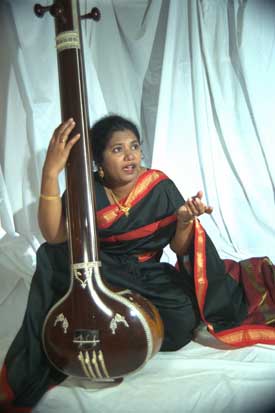North Indian Vocal form

Kheyal (a.k.a. “Khyal) has a special place in Indian music. The word “kheyal” in Urdu means “idea” or “imagination”. This term is indicative of its highly improvisational nature. It is generally an abstract and complete presentation of the rag; It is probably the most improvised of the Indian styles.
There are two major movements of kheyal. There is an extremely slow section which is called vilambit, or bada kheyal: and a fast section called drut or chotta kheyal. The vilambit section is extremely slow and usually played in ektal of 12 beats. Occasionally, other tals such as jhumra of 14 beats are heard but this is most rare. The fast section is usually played in drut tintal or drut ektal.
The instrumental accompaniment to the kheyal is consistent with that of most north Indian classical music. This consists of harmonium, tanpura and tabla. Very often the harmonium is replaced with the sarangi; historically this was the preferred melodic accompaniment.
| THESE BOOKS MAY NOT BE FOR YOU |
|---|
A superficial exposure to music is acceptable to most people; but there is an elite for whom this is not enough. If you have attained certain social and intellectual level, Elementary North Indian Vocal (Vol 1-2) may be for you. This has compositions, theory, history, and other topics. All exercises and compositions have audio material which may be streamed over the internet for free. Are you really ready to step up to the next level? Check your local Amazon. |
History
The history of the kheyal (khyal) is pivotal to the development of the modern style of Hindustani classical music. Previously, the common styles were the dhrupad, and dhammar. These earlier styles were more somber and generally associated with the royal court.
The early development of the kheyal reflected a system of sexual segregation; this is known as “pardah”. In this system, men and women were kept in separate places in the royal palaces. The men’s activities were commonly held in the royal courts, these are known as “durbar”, while the women were relegated to their quarters, which is known as “zanaana”.
Architecture played a surprising role in the development of both the kheyal as well as the dhammar and dhrupad. The men commonly sang in the royal courts. These were big, and had no sound systems, therefore the masculine forms (e.g., dhrupad, dhammar) became very loud and devoid of delicacy. The kheyal was sung in much smaller women’s quarters so there was not the necessity to sing so loudly; consequently, the kheyal was able to develop much more delicacy. Men singing in the royal courts had to deal with very reverberant environments, so any attempt to sing very fast material would simply be washed out in the echoes of the durbar. In contrast, women singing in the smaller zanaanas could explore the full range from slow to fast material.
It is no surprise that kheyal, unfettered by the acoustic constraints of the royal court, should become very popular. However, there were social obstacles which hampered its formal acceptance into the larger system of North Indian music. These obstacles were reflected in the gender roles that were part of Indian society in that period.
These gender roles were reflected in a guild system known as “gharana”. From the collapse of the Mogul empire (18th century) to the time of Independence (1947) these gharanas were important for such activities as the allocation of royal patronage, the definition of artistic styles, and the education of new musicians to replace those who were lost through sickness and death. These gharanas maintained a formalised syllabus that musicians would use for both performance as well as educational purposes. Such a body of educational material is known as “taleem”. The gender roles were reflected in a simple way. Until the turn of the 20th century the teachers were almost exclusively male, therefore the feminine art-forms were excluded from the formal taleem.
A very significant shift occurred in the 18th century. In this period, men began to sing the kheyal. This movement was spearheaded by two great musicians. One of them was Sadarang (1670-1748) and another was Adarang (18th century). The collapse of the gender obstacles heralded the mass acceptance of the kheyal in northern India.
Over the next few centuries, a number of gharanas of kheyal would develop. These were the Gwalior, Agra, Kirana, Jaipur, Rampur, Delhi, Mewati, Bhendi Bazaar, Benares, and Patiyala gharanas. Each would have its own style and repertoire.
Today, the kheyal is considered to be the benchmark for North Indian Classical music.
Selected Video
Other Sites of Interest
Women as a Proposition to Explicit the Esthetic Values of North Indian Classical Vocal Music
Multiple Viewpoint Modeling of North Indian Classical Vocal Compositions
Sonic Performativity: Analysing Gender in North Indian Classical Vocal Music
